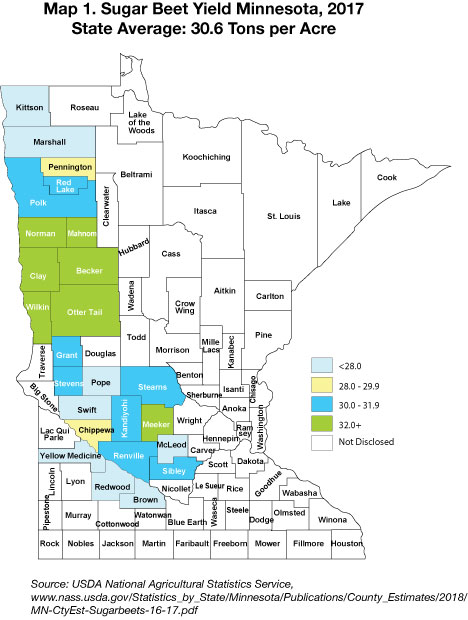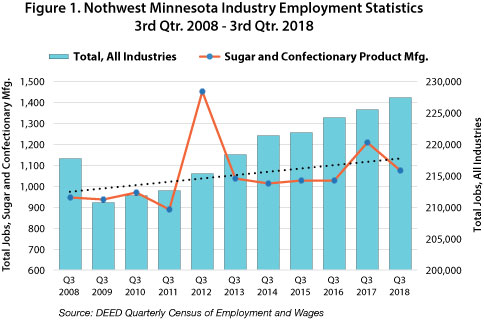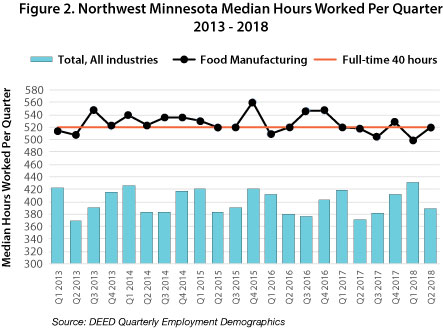by Cameron Macht
April 2019
As the birthplace of the snowmobile, Northwest Minnesota is well known for its high concentration of employment in the Transportation Equipment manufacturing industry. But another manufacturing sector that benefits from the cold winter weather is also a distinguishing industry in the region – Sugar and Confectionary Manufacturing.
In their U.S. Sugar Production Background report the U.S. Department of Agriculture's Economic Research Service states that "the largest and most dynamic region for sugar beet production is in or close to the Red River Valley of western Minnesota and eastern North Dakota… the Red River region increased consistently through the 1990s and into the 2000s and has accounted for the majority of total planted U.S. sugar beet acreage. Long, cold winters aid the storage of sugar beets harvested in October and allow the slicing of sugar beets well into the following spring, thereby making more efficient use of slicing capacity at the factories."
But as important as the cold winter weather is, the region's temperate climatic conditions in the summer and fertile soil also leads to an excellent growing environment. Map 1 shows that Northwest Minnesota has the most productive land for sugar beet yields in the state. According to the Red River Sugarbeet Growers Association, well over 2,500 farmers grow sugar beets for the cooperative and the five factories in the region, including three on the Minnesota side of the border.

Through 2018 Minnesota was easily the largest producer of sugar beets in the United States, with more than 415,000 acres planted and nearly 10.5 million tons of beets produced. Eight of the top 11 counties in the state for sugar beets are located in Northwest Minnesota, including four of the top five and the number one county in the state: Polk County. What's more, Polk County also ranks first in the entire United States for sugar beets – and Northwest Minnesota is home to eight of the top 34 counties for sugar beets nationwide.
County estimates from the USDA put Northwest Minnesota's sugar beet production at just over 8.9 million tons in 2017, and with an average price of about $46 per ton, that means more than $410 million in sales. That was down from approximately $50 per ton and $470 million in sales in 2016. However, an AgWeek article published in April 2019 stated that the estimated payment for 2018 crop beets will rise to $51 per ton, an important boost for an otherwise depressed farm economy that is struggling with low commodity prices for other crops including corn and soybeans.
In addition to the more than 2,000 farmers who grow sugar beets, Northwest Minnesota also has about 1,100 jobs at the eight sugar and confectionary product manufacturing establishments operating in the region. That yields a location quotient of 7.7 – meaning these jobs are nearly eight times more concentrated in Northwest Minnesota than the rest of the United States. At just over $54,000, average annual wages were also higher at sugar and confectionary product manufacturers than the total of all industries and even other manufacturing sectors (see Table 1).
| Table 1. Northwest Minnesota Industry Employment Statistics, Qtr. 3 2018 | |||||||
|---|---|---|---|---|---|---|---|
| NAICS Industry Title | NAICS Code | Number of Firms | Number of Jobs | Quarterly Payroll | Average Annual Wages | ||
| Total, All Industries | 0 | 17,347 | 227,439 | $2,271,726,061 | $39,936 | ||
| Manufacturing | 31 | 838 | 29,718 | $363,275,623 | $48,880 | ||
| Food Manufacturing | 311 | 89 | 5,976 | $72,329,337 | $48,412 | ||
| Sugar and Confectionery Product Manufacturing | 3113 | 8 | 1,076 | $14,561,343 | $54,080 | ||
| Source: DEED Quarterly Census of Employment and Wages | |||||||
Beet sugar manufacturers averaged just under 150 workers per site in 2017 compared to just 13.3 jobs per establishment across all industries in the region. After slicing jobs during the Great Recession and dropping as low as 888 jobs in the third quarter of 2011, the region has seen a steady recovery so far this decade. In fact, employment in sugar and confectionary product manufacturing has increased three times faster than the total of all industries between 2008 and 2018, enjoying a 14 percent increase. The region saw an even bigger spike during 2012, but much of that employment fluctuation was caused by a lockout that finally ended in May 2013 after a bitter 22-month ordeal. Long-term, the trendline shows that the sugar and confectionary product manufacturing operations in the region are expanding to meet demand (see Figure 1).

Likewise, USDA research shows that even though the number of farms growing sugar beets was declining, the average area harvested per farm was increasing. As the farms were getting bigger, yields were also increasing over time – with tons per acre rising more than 35 percent over the past decade in the counties in Northwest Minnesota.
This employment growth has not only created opportunities for farmers and farmworkers, it has also raised demand for workers at the sugar and confectionary product manufacturing plants. Of the top 15 occupations in demand in the industry, 13 can be started with a high school diploma or less, but a couple also benefit from having some vocational training or related work experience.
Not surprisingly, the lowest skilled jobs – such as packers and packagers, retail salespersons and cashiers, and janitors and cleaners – offer the lowest wages. However, several occupations – including general and operations managers, first-line supervisors, sales representatives, and industrial machinery mechanics – provide higher wages and good long-term career prospects (see Table 2).
| Table 2. Top 15 Occupations in Demand in Sugar and Confectionary Product Manufacturing, 2018 | ||||||
|---|---|---|---|---|---|---|
| SOC Code | SOC Occupational Title | Typical Education Required | Estimated Regional Employment | 25th Percentile Wage | Median Hourly Wage | 75th Percentile Wage |
| 513092 | Food Batchmakers | High school or less | 570 | $12.54 | $14.05 | $15.67 |
| 519111 | Packaging and Filling Machine Operators | High school or less | 1,140 | $12.62 | $15.29 | $18.37 |
| 537064 | Packers and Packagers, Hand | High school or less | 600 | $10.35 | $11.76 | $14.39 |
| 412031 | Retail Salespersons | High school or less | 6,060 | $10.17 | $12.17 | $14.65 |
| 537062 | Laborers, Freight, Stock and Material Movers | High school or less | 2,940 | $12.21 | $14.31 | $17.25 |
| 511011 | First-Line Supervisors of Production Workers | High school or less | 1,400 | $22.24 | $26.50 | $33.50 |
| 499041 | Industrial Machinery Mechanics | Vocational training | 600 | $17.43 | $20.64 | $25.34 |
| 519198 | Helpers--Production Workers | High school or less | 790 | $12.88 | $14.77 | $17.66 |
| 412011 | Cashiers | High school or less | 6,890 | $9.80 | $10.60 | $11.77 |
| 499071 | Maintenance and Repair Workers, General | High school or less | 2,160 | $15.06 | $18.32 | $22.54 |
| 513093 | Food Cooking Machine Operators | High school or less | 130 | $12.55 | $14.55 | $17.43 |
| 519199 | Production Workers, All Other | High school or less | 310 | $12.86 | $14.57 | $17.14 |
| 537051 | Industrial Truck and Tractor Operators | High school or less | 690 | $14.80 | $18.01 | $22.05 |
| 111021 | General and Operations Managers | Bachelor's degree | 2,520 | $23.68 | $32.99 | $47.55 |
| 414012 | Sales Representatives, Wholesale and Mfg. | High school or less | 1,940 | $15.82 | $23.86 | $31.67 |
| 372011 | Janitors and Cleaners | High school or less | 3,390 | $11.22 | $13.83 | $17.32 |
| Source: DEED Occupational Employment Statistics, Minnesota Educational Requirements for Occupations | ||||||
Sugar beet harvest also requires hundreds of truck drivers and temporary seasonal employees who work at the piling stations. Weather-permitting, harvest typically begins in late September or early October, and it runs hot and heavy until completed. This often means three weeks or more of 24 hours a day, seven days a week harvesting activities.
Beyond that, Figure 2 shows that many workers in the industry receive overtime hours and pay through the year, especially during the third and fourth quarters. According to data from DEED's Quarterly Employment Demographics program, median hours worked in Food Manufacturing in Northwest Minnesota were above a full-time, 40-hour a week schedule in 17 of the past 22 quarters. Median hours peaked in the fourth quarter of 2015 at 560 hours and averaged about 10 hours more per week than the total of all industries (see Figure 2).

Median hourly wages in Food Manufacturing also tend to peak during the third and fourth quarter of each year, leading to bigger paychecks throughout the winter. That's a sweet deal indeed.
Sweet OpportunityOne sweet opportunity the region can boast about is that a Minnesota sugar beet farmer's wife, known for her popular blog and best-selling cookbook, now has her own show on the Food Network. According to her bio on the Food Network site, "Molly Yeh is the star of Food Network's new series Girl Meets Farm. She rose to national prominence with the debut of her memoir, Molly on the Range: Recipes and Stories from an Unlikely Life on a Farm. Her cookbook was selected by the New York Times as one of the fall's top releases of 2016 and was the winner of the International Association of Culinary Professionals (IACP), 'Judge's Award.' The book was also selected by NPR as one of their Great Reads of 2016."6 |
1Background. United States Department of Agriculture Economic Research Service.
2The Sugarbeet Growers Association Story. Red River Valley Sugarbeet Growers Association.
4Pates, Mikkel. "American Crystal boosts 18-crop beet price to $51 per ton." April 2, 2019. AgWeek.
5Hughlett, Mike. "American Crystal Sugar lockout ends." StarTribune May 28, 2013.